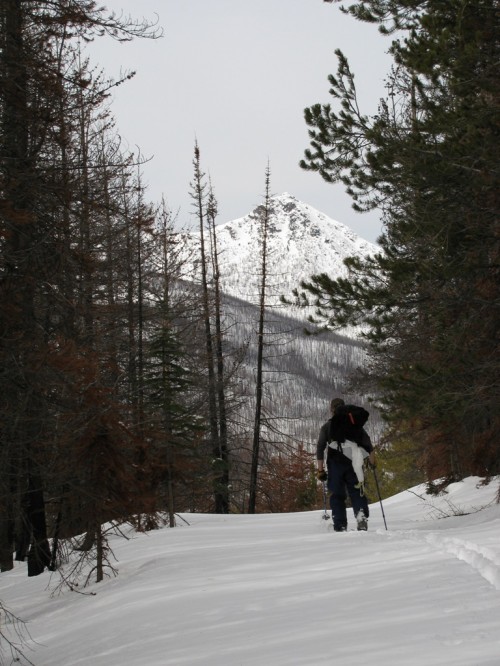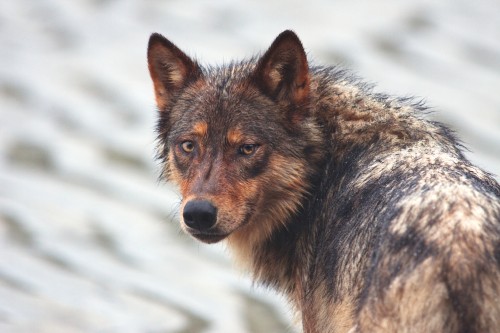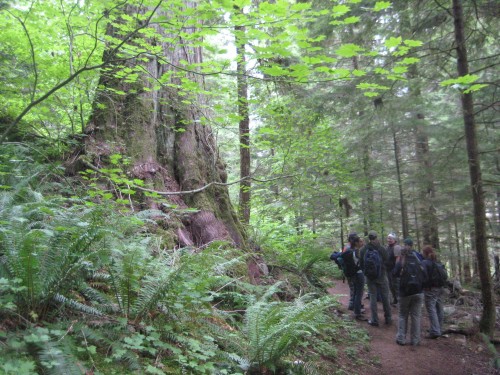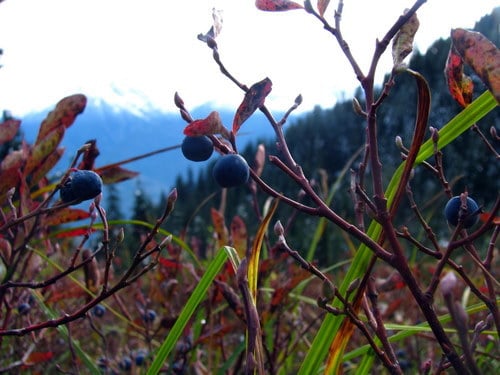Hope Within Wildness

Written as an essay for the Conservation Psychology class at Western Washington University.
“In wildness lies the hope of the world.” John Muir
Today, our world faces many problems that can seem overwhelming and almost too much to bear. In a world facing issues such as climate change, terrorism, racism, poverty, hunger, etc it is easy to become distraught. When we are exposed to multiple media sources each day and countless advertisements we start to lose the ability to cope and think for ourselves. Far more dangerous than any social or environmental issue are the issues of ignorance and apathy plaguing society. In the world of environmental work the weight of these issues can become overbearing and lead to anxiety, depression and a sense of helplessness that prevents us from doing our work effectively. It is important in times like these that we do not lose hope. Hope is the antidote to apathy, and when apathy is eliminated ignorance can be as well.
In this paper I will discuss how hope might be our greatest weapon to defeating our world’s problems today and how we can prevent a sense of hopelessness when society tells us there is none remaining. I will discuss how we must look to wildness for inspiration and how in wildness some of our hope can be restored. Spending time in nature and preserving our wild areas can foster hope in a seemingly hopeless world. It is important that people in environmental work are able to find success stories and sources of inspiration to restore their hope so they can in turn fight apathy and ignorance and restore hope within others.
Unfortunately, studies indicate that learning about global problems can trigger profound feelings of anxiety, helplessness, and hopelessness (Eckersley, 1999; Hicks & Bord, 2001; Holden, 2007; Searle & Gow, 2010; Taber & Taylor, 2009; Tucci, Mitchell, & Goddard, 2007). It is important then that we seek out sources of hope and inspiration to help guide us and keep us motivated in challenging times. It can be difficult to find these sources, especially in environmental work. “Conservationists live with a high degree of negative emotional experience as part of their daily awareness of the problems that ensue from human degradation of the natural environment…Prophecies of a doomed planet may not only miss their intended audience but may also cause extreme emotional distress among those working in environmental advocacy” (Fraser et al, 2013).
According to Cheryl Hall, “ Gloom and doom foster despair and resistance, they worry instead of hope and motivate to change” (Hall, 2013). Stress in environmental work is rooted in knowledge and beliefs, specifically with environmental loss (Clayton & Myers, 2009). It is important then that people in environmental work find some stories of environmental gain and success to rekindle hope. Finding success stories that they can grasp on to and keep them motivated is vital to eliminate feelings of powerlessness and hopelessness. Even in bleak times such as these, stories and symbols of hope do exist. Success stories associated with the endangered species act and the preservation of wilderness are stories that, when looked at correctly, can rekindle our sense of hope to keep us motivated amongst the doom and gloom.

In Joanna Macy’s book Active Hope she claims that when we become aware of an emergency and rise to the occasion, something powerful gets switched on inside us. We activate our sense of purpose and discover strengths we didn’t even know we had (Macy, 2012). This can be true of when we look at our success stories in our successful campaigns to preserve wildness where we have acted on behalf of something larger than ourselves. In the face of deteriorating habitat loss and biodiversity we have risen above what was believed to be possible. The story of the spotted owl is evidence of Macy’s claim. Through protecting an endangered species, environmentalists managed to protect and preserve large tracts of old growth forest. It is in stories like these in which environmental professionals must look to for inspiration, motivation, and hope. Millions of people are now aware of the importance of the dynamics of old growth forest to all life within the ecosystem. Through the spotted owl and the work of environmental professionals people’s ignorance has been altered, apathy reduced, and hope rekindled.
There are several other species other than the spotted owl that have re-emerged from the verge of extinction to which we can look at for inspiration. Many animals once on the threshold of extinction are now making a comeback and increasing their numbers. Species such as grizzly bears, bald eagles, grey wolves, and whooping cranes were all once on the brink of extinction, but have managed to mount resilient comebacks. It is in the success stories of these species, through their resiliency to persist and our willingness to not simply let them fade into the annals of natural history where we can look to for hope. We can learn from these species and we can learn from ourselves through how we have helped these species. If we nearly brought whooping cranes back from the dead, then we may be able to shift our ways to a more sustainable way of living that will not only help other species, but help ourselves as humans as well.
When faced with near eradication, wolves didn’t simply die out and give up, nor should we in the face of environmental problems. There is a persistence and resiliency in these animals to survive and regain former ground that we as humans can look to for inspiration. Looking at wolves’ resiliency and our willingness as humans to help them can bring about positive emotions such as joy, awe, interest, amusement, etc. Positive emotions such as these can bring about senses of optimism and hope, accomplishment, meaning, and purpose, which are all vital aspects of positive psychology (Clayton &Myers, 2009). It is important that environmental professionals are able to counter doom and gloom with these aspects of positive psychology and know where to look for there sources of hope to remain balanced in their work and passion to prevent feelings of powerlessness and prevent the dangers of apathy.
Animals live very simplistic lives, focusing on only their basic needs, in doing so they restore balance to ecosystems. Looking at success stories of recovered endangered species can build upon a new fascination with the natural world. Environmental educators have the ability to relay these success stories to reach a wider audience through outreach and education to encourage a deepened human-nature relationship. “Building a stronger human-nature relationship is essential if societies are to put appropriate values on healthy ecosystems, and it can begin with the positive effects nature has on people” (Myers & Clayton, 2014). By realizing the hope brought about by endangered species success stories environmental educators can effectively encourage a stronger human nature relationship to a broader audience.

Looking to animals and wildness for hope can bring about what E.O. Wilson describes as “bilophilia”, the instinctive bond that exists between humans and other living systems (Wilson, 1984). “Biophilia” can offer humans a way to think of the positive contribution of the nature to human well being (Clayton and Myers, 2009). This can apply to what we learn from animals. Wolves in particular are highly social creature, much as humans are. When we look at their success story in a positive light we can strengthen our biophilic connection to the natural world. Animals and their simplistic way of living and way of meeting their basic needs can be a lesson to us humans. If the biophilic connection to nature is formed from hope within wildness and through the resiliency of animals to survive, then we may begin to see that we can live a simpler and more meaningful way of life. A wolf pack is a great example of this and environmental educators can take inspiration from their story to reach out and interpret this to a wider audience.
Leopold once said that naturalists see the world in terms of wounds. Where I believe there is much truth to this statement, I also feel that in those wounds is the resiliency of the planet to restore itself to natural balance. There in lies the hope of the planet. Nothing in nature simply gives up without a fight. Natural systems will show extraordinary resiliency to restore itself to balance. We as humans have created a shift towards imbalance, but being part of the planet we have the ability to show this same resiliency and restore ourselves to balance. We must look to the planet and wildness for hope and inspiration to see our own resiliency to restore our own species to balance and harmony with the rest of the natural world.
Looking at these success stories of endangered species can be applied to Zimmerman’s proposed theory of learned hopefulness, where one sees hope in the perceived and actual control over circumstances. Our ability and control to bring species back and protect the surrounding habitat and wilderness areas is an example of how environmental workers can apply and utilize the theory of learned hopefulness, which can in turn help them successfully cope with adverse circumstances and solve problems (Christens et al, 2013).
We need something to reconnect us to wildness, to restore our hope. We need to see the joy in living simplistically, and that consumption and materialism do not necessarily make us happy. If we can find the joy and happiness in living simply and having our basic needs met then we can gradually reduce our consumer habits. A great metaphor that reconnects us to our primal selves is backpacking. By setting out for a day, week, or month with all of our amenities loaded in a pack we can start to see that we do not need frivolous luxuries to be happy. Wildness can restore some of our hope, just as Muir said. It is therefore important that in the work of environmental education that educators, naturalists, scientists, and activists find these places of refuge where beauty and wildness still persist.

By reconnecting to a more simplistic way of being, we can restore our awe and wonder in the natural world. Awe can bring about much positive emotion and humans respond unconsciously with positive emotion to settings or features that would have aided survival of our ancestors (Clayton & Myers, 2009). Clayton and Myers also suggest that time spent in nature reduce anger, hostility, confusion, depression, and anxiety. These positive effects brought about by nature and wildness can form a connection to the natural world that can bring about and restore hope to environmental professionals who then can in turn pass that hope along to others.
In outdoor activities such as backpacking that connect us to wild areas we can become more mindful of our experience and our surroundings, which is an aspect of positive psychology. Mindfulness is a quality of openness or receptive awareness and attention to internal or external events (Clayton & Myers, 2009). Mindfulness simply brings about more concentration and awareness to the present moment and place. With a combination of awe and enhanced awareness to that awe contributed by mindfulness people can experience positive emotions toward the natural world that can bring about a deeper sense of meaning and interconnectedness to all life, which is yet another aspect of positive psychology.
Finding hope in wildness and in the restoration in wildness can bring about a greater sense of interconnectedness. Research exploring what mediates nature’s effects finds that some measure of connection to nature rather than simply exposure to nature is related to positive psychology outcomes (Clayton & Myers, 2009), hope could be one of these positive psychological outcomes. Connectedness to nature is related to meaning in life and vitality (Clayton & Myers, 2009). Seeing a connection to wild animals and the hope brought about through their success can bring about hope within our own lives as environmental professionals.
Joanna Macy stresses the role of interconnectedness to active hope. “When we carry within us a deep appreciation of how life is sustained by other living beings, we strengthen our desire to give back” (Macy, 2012). Macy states that active hope involves being an activist for what we hope for the world. A key aspect to active hope is the encouraging boost we get when we know we’re moving forward, we need to find markers of progress we can spot more easily and often (Macy, 2012). The current interest in outdoor activities, our willingness to preserve and expand wilderness areas, and the success stories of eagles and wolves are these markers of progress that can not only restore our hope, but allow us as environmental professionals to convey that hope onto the world, inspiring others to act and take action to create a better world for all the earth.

When despair for the world grows in me
and I wake in the night at the least sound
in fear of what my life and my children’s lives may be,
I go and lie down where the wood drake
rests in his beauty on the water, and the great heron feeds.
I come into the peace of wild things
who do not tax their lives with forethought
of grief. I come into the presence of still water.
And I feel above me the day-blind stars
waiting with their light. For a time
I rest in the grace of the world, and am free.
-Wendell Berry
Works Cited
Clayton, Susan, Clayton, Susan D., & Myers, Gene. (2009). Conservation Psychology Understanding and Promoting Human Care for Nature. Hoboken: Wiley.
Leopold, A., & Schwartz, Charles Walsh. (1966). A Sand County almanac. With other essays on conservation from Round River. (Enl. ed.]. ed.). New York: Oxford University Press.
Macy, J., & Johnstone, C. (2012). Active hope: How to face the mess we’re in without going crazy. Novato, Calif.: New World Library.
Macy, J. (2007). World as lover, world as self courage for global justice and ecological renewal. Berkeley, Calif.: Parallax Press.
Christens, B., Collura, J., & Tahir, F. (2013). Critical Hopefulness: A Person-Centered Analysis of the Intersection of Cognitive and Emotional Empowerment. American Journal of Community Psychology Am J Community Psychol, 170-184.
Wilson, E. (1984). Biophilia. Cambridge, Mass.: Harvard University Press.
Berry, W. (1998). The selected poems of Wendell Berry. Washington, D.C.: Counterpoint.

